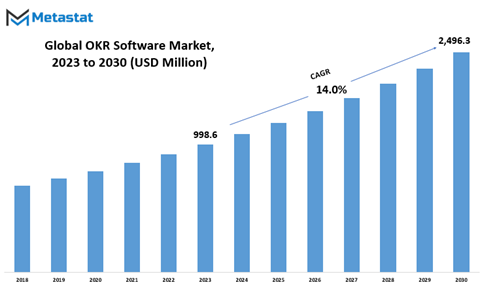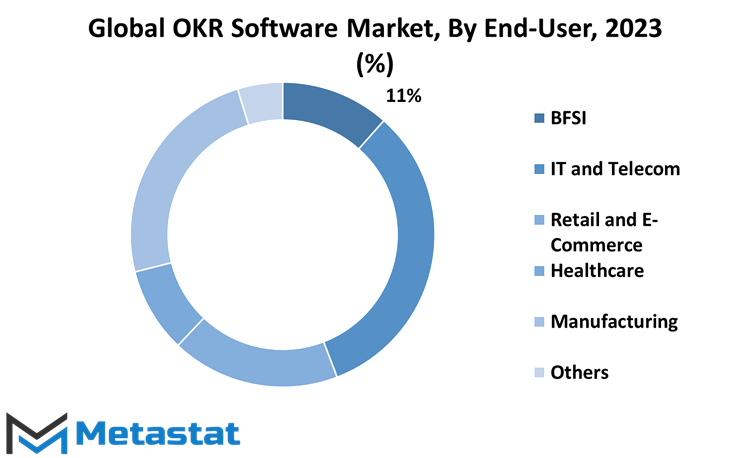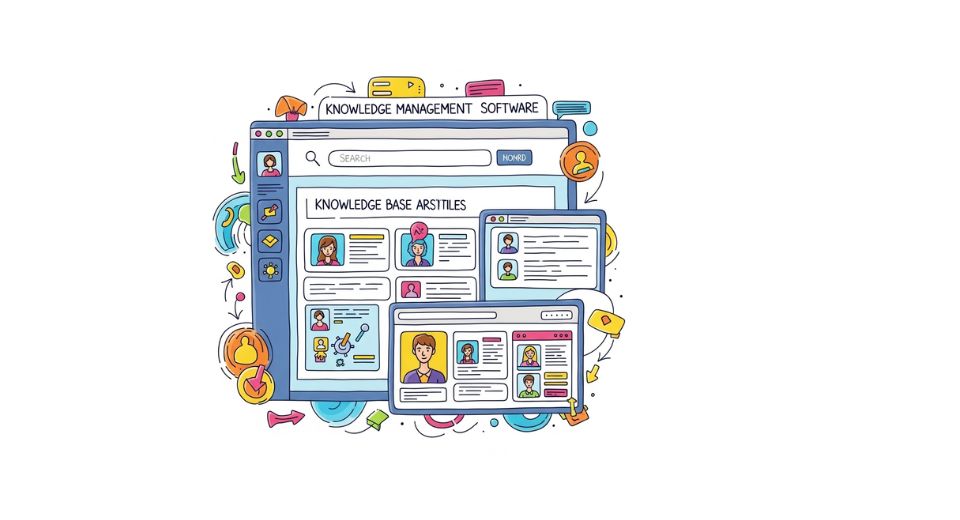MARKET OVERVIEW
The OKR Software market is a testament to the increasing reliance of organizations on tools that enhance goal-setting processes. OKR, an acronym for Objectives and Key Results, represents more than just a set of buzzwords; it embodies a strategic approach to goal management that has become integral to contemporary business practices.
OKR software serves as a robust solution for organizations aiming to define and track their goals and objectives in a quantifiable and transparent manner. The software is engineered to transcend the limitations of traditional goal-setting methods, providing a dynamic platform that promotes collaboration, communication, and alignment across diverse teams and departments within an organization.
The significance of OKR software lies in its ability to foster a results-oriented culture within an organization. By establishing clear objectives and measurable key results, the software empowers teams to focus on outcomes rather than merely completing tasks. This shift in mindset not only enhances productivity but also cultivates a sense of purpose and direction among employees, contributing to overall organizational success.
Importantly, OKR software functions as a strategic enabler, facilitating agile adaptation to the dynamic business landscape. In a world characterized by rapid changes and evolving market demands, organizations need tools that can help them pivot swiftly without losing sight of their overarching objectives. OKR software, with its adaptability and real-time tracking capabilities, positions itself as a key driver in navigating the challenges of an ever-changing business environment.
The OKR Software market's exponential growth reflects the profound impact of goal-oriented strategies on organizational success. As organizations continue to recognize the significance and importance of aligning objectives with measurable results, the role of OKR software will remain pivotal in shaping a future where goals are not just set but achieved with precision and efficiency.
Global OKR Software market is estimated to reach $2,496.3 Million by 2030; growing at a CAGR of 14.0% from 2023 to 2030.

GROWTH FACTORS
The OKR Software Market, the impetus for its growth is rooted in the demand for a structured approach to goal-setting and tracking. This need arises from the ever-growing importance of driving organizational success and accountability. The software serves as a catalyst, providing a systematic way for businesses to set objectives and measure key results, fostering a sense of direction and responsibility.
A significant driver amplifying the market's trajectory is the burgeoning demand for remote work solutions. These solutions play a pivotal role in keeping teams aligned and focused, especially in the context of a distributed work environment. The software becomes an essential tool, ensuring that teams can collaboratively work towards common goals regardless of physical location, enhancing overall efficiency and coherence.
However, among the market's promising trajectory, certain factors pose challenges. One such challenge is the resistance to change and a general reluctance to adopt new technology or processes. This inertia can impede the seamless integration of OKR software into organizational workflows, hindering the realization of its full potential.
Additionally, the complexity and potential cost associated with implementing and maintaining an OKR software solution present further hurdles. The intricacies involved in deploying such a system may deter organizations, particularly those with limited resources, from fully embracing this technology-driven approach to goal-setting and tracking.
Yet, amid these challenges lie lucrative opportunities for the market's growth. The ability to improve organizational performance and achieve better business outcomes emerges as a beacon of promise. By leveraging a data-driven approach to goal-setting and tracking, businesses can unlock new avenues for success. The insights provided by OKR software empower organizations to make informed decisions, optimize strategies, and enhance overall efficiency.
As organizations recognize the potential benefits of adopting OKR software, the market is poised for significant expansion in the coming years. The transformative power of this technology, coupled with its capacity to align teams, enhance accountability, and foster a data-driven culture, positions it as a valuable asset in the ever-evolving landscape of organizational management.
MARKET SEGMENTATION
By Deployment Type
The OKR Software Market, in its landscape of deployment options, delves into the realms of accessibility and implementation. Two primary deployment types emerge: Cloud and On-premise. Cloud deployment, representing the contemporary trend, involves the use of remote servers accessed through the internet. On-premise, on the other hand, signifies the traditional method where the software is installed and operated on local servers and computing infrastructure.
Cloud deployment, with its emphasis on accessibility and scalability, has gained prominence in the modern business ecosystem. By leveraging the power of remote servers, organizations can access the software from anywhere with an internet connection, fostering flexibility and collaboration. This deployment type is particularly advantageous for businesses seeking quick implementation and the ability to scale resources based on demand.
Conversely, On-premise deployment persists as a viable option, catering to businesses with specific security and compliance requirements. With the software residing within the organization’s physical infrastructure, On-premise deployment provides a sense of control over data and applications. This option is often favored by enterprises operating in regulated industries or those with stringent data privacy concerns.
The choice between Cloud and On-premise deployment in the OKR Software Market boils down to a balance between modern flexibility and traditional control. While Cloud deployment offers agility and accessibility, On-premise deployment provides a sense of security and adherence to specific regulatory frameworks. As organizations navigate their digital transformation journey, the selection of the most suitable deployment type becomes a pivotal decision, shaping the efficiency and adaptability of OKR software within their operational framework.
By Enterprise Size
In the dynamic landscape of the OKR Software Market, enterprise size delineates the market's diverse user base. It is segmented into Small and Medium Enterprises (SMEs) and Large Enterprises, each representing distinct segments with unique characteristics and requirements. The Small and Medium Enterprises segment, valued at 344.2 USD Million in 2022, signifies the prevalence and adoption of OKR software among businesses with relatively smaller operational scales.
On the other hand, the Large Enterprises segment, valued at 537.9 USD Million in the same period, highlights the substantial utilization of OKR software in more extensive and complex organizational structures. This segmentation aligns with the diverse needs and scopes of enterprises, where smaller entities find value in streamlined goal-setting and performance management, while larger organizations benefit from the scalability and comprehensive features offered by OKR software.
This division by enterprise size underscores the adaptability of OKR software across a spectrum of business dimensions. It caters to the nuanced requirements of SMEs seeking efficient and focused goal management and the intricate needs of large enterprises grappling with more extensive and multifaceted organizational objectives. The market, through this segmentation, reflects the versatility of OKR software as a tool that transcends the boundaries of enterprise size, providing value to businesses regardless of their scale and operational intricacies.
By End-user
The OKR Software Market displays a diversified landscape, with end-users carving out distinct sectors to leverage the benefits of Objectives and Key Results (OKR) frameworks. Among these sectors, the BFSI domain stands as a prominent player, recognizing the efficacy of OKR methodologies in aligning organizational goals and driving performance metrics. Embracing the OKR Software, the BFSI sector seeks to enhance strategic planning, optimize resource allocation, and elevate overall operational efficiency.
In tandem with BFSI, the IT and Telecom sector emerges as a robust player in the OKR Software Market. Faced with the dynamic nature of the tech industry, organizations within this sector harness OKR solutions to foster agility, streamline project management, and foster innovation. The adaptable nature of OKR frameworks aligns seamlessly with the fast-paced demands of IT and Telecom, providing a structured yet flexible approach to goal-setting and achievement.
Retail and E-Commerce, another pivotal segment, embraces OKR Software to navigate the competitive landscape. In an industry where customer preferences evolve rapidly, organizations deploy OKR methodologies to enhance customer experience, optimize supply chain operations, and respond swiftly to market trends. OKR frameworks offer a strategic compass for Retail and E-Commerce entities, ensuring agility in goal adaptation and achievement.
Healthcare, too, stands as a noteworthy end-user in the OKR Software Market, recognizing the transformative impact of OKR frameworks on organizational performance. The healthcare sector leverages OKR solutions to enhance patient care, streamline administrative processes, and promote collaboration among diverse healthcare professionals. The adaptable nature of OKR methodologies proves beneficial in the ever-changing healthcare landscape.
Manufacturing, characterized by intricate production processes, integrates OKR Software to enhance operational efficiency and strategic planning. OKR frameworks empower manufacturing units to set and monitor production goals, optimize resource allocation, and respond adeptly to market demands. The sector's adoption of OKR solutions underscores the versatility of these frameworks in diverse operational contexts.
Within the broad spectrum of end-users, the category labeled as 'Others' encapsulates various industries recognizing the value of OKR methodologies. This heterogeneous group signifies the universal applicability of OKR Software across sectors not explicitly outlined, showcasing the adaptability of OKR frameworks to diverse organizational structures and goals.

REGIONAL ANALYSIS
The landscape of the OKR Software Market unfolds across the globe, with geographical divisions offering insights into its global reach. Two significant regions that play a crucial role in shaping this market are North America and Europe. These regions serve as focal points for the utilization and growth of OKR software, each contributing uniquely to the market dynamics.
In North America, the OKR Software market finds a robust foothold, driven by the adoption of advanced technologies and a strong emphasis on goal-oriented strategies within businesses. The market dynamics in North America are influenced by a tech-savvy business culture, where organizations prioritize efficient goal-setting and tracking. The region's economic prowess and a proactive approach toward embracing innovative business solutions further propel the adoption of OKR Software.
Similarly, in Europe, the OKR Software market thrives, benefiting from the continent's diverse business landscape and a strategic approach to organizational goal management. European businesses recognize the value of aligning individual and team objectives with overarching organizational goals. The adoption of OKR Software in Europe is spurred by a commitment to enhancing productivity and fostering a culture of transparency and accountability within enterprises.
Both North America and Europe contribute significantly to the global OKR Software market, acting as influential players in shaping its trajectory. The adoption of OKR methodologies in these regions signifies a broader shift in how businesses approach goal management, emphasizing agility, adaptability, and measurable outcomes. The OKR Software market, through its presence in North America and Europe, reflects the global trend toward more effective and streamlined goal-setting practices in today's competitive business landscape.
COMPETITIVE PLAYERS
In the OKR Software Market, key players stand out, steering the industry's course. Notable among them are 15Five Inc. and Betterworks Systems Inc., both contributing significantly to the evolution of OKR software solutions. These players navigate the competitive field, offering platforms designed to enhance organizational performance through effective goal-setting and alignment.
15Five Inc. brings its expertise to the fore, leveraging its position as a key player in the OKR Software Market. With a focus on fostering continuous feedback and employee engagement, 15Five's solutions are tailored to meet the dynamic needs of modern organizations. The company's commitment lies in providing tools that facilitate transparent communication and goal tracking, aligning teams towards shared objectives.
In tandem, Betterworks Systems Inc. adds its weight to the realm of OKR software, offering comprehensive solutions aimed at driving organizational excellence. By providing a robust framework for setting, tracking, and achieving objectives, Betterworks aligns workforce efforts with strategic goals. The company's contribution extends beyond mere software provision; it's integral to the fabric of organizations aspiring to enhance productivity through effective goal management.
These key players, 15Five Inc. and Betterworks Systems Inc., epitomize the dynamism within the OKR Software Market. Their offerings not only cater to the essential functionalities of goal-setting and tracking but also reflect an understanding of the contemporary organizational landscape. In a world where effective goal management is a linchpin for success, these players play a pivotal role in shaping the trajectory of the OKR Software Market.
OKR Software Market Key Segments:
By Deployment Type
- Cloud
- On-premise
By Enterprise Size
- Small and Medium Enterprises
- Large Enterprises
By End-user
- BFSI
- IT and Telecom
- Retail and E-Commerce
- Healthcare
- Manufacturing
- Others
Key Global OKR Software Industry Players
- 15Five Inc.
- Betterworks Systems Inc.
- Lattice
- Quantive
- Perdoo GmbH
- co
- Weekdone OÜ
- WorkBoard Inc.
- Microsoft Corporation
- Leapsome
- Mooncamp GmbH
- Charma
- Imagine Just3Things Ltd.
- com Ltd.
- Asana, Inc.
WHAT REPORT PROVIDES
- Full in-depth analysis of the parent Industry
- Important changes in market and its dynamics
- Segmentation details of the market
- Former, on-going, and projected market analysis in terms of volume and value
- Assessment of niche industry developments
- Market share analysis
- Key strategies of major players
- Emerging segments and regional growth potential








 US: +1 3023308252
US: +1 3023308252






